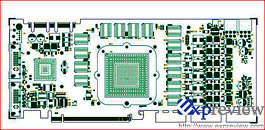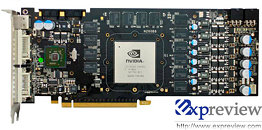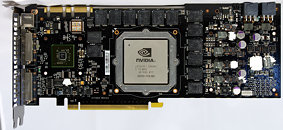Saturday, February 7th 2009

NVIDIA Designs New GTX 260 PCB, Further Reduces Manufacturing Costs
The introduction of the new G200b series graphics processors sought to revive NVIDIA's stronghold over the high-end graphics market, by reducing manufacturing costs, and facilitating high-end graphics cards at unusually low price-points, to compete with rival ATI. The first SKU using the G200b GPU was the new GeForce GTX 260. The PCB of design of the new model (P654) saw several drastic changes, that also ended up contributing to the cost-cutting: all memory chips were placed in the business end of the PCB, and the VRM area rearranged. News emerging from Expreview suggests that NVIDIA has worked out an even newer PCB reference design (model: P897) that aims mainly to cut production costs further. The reference design graphics board based on the PCB will be given the internal name "D10U-20". A short list of changes is as follows:
Source:
Expreview
- The number of PCB layers has been reduced from 10 to 8, perhaps to compress or remove blank, redundant or rudimentary connections
- A 4+2 phase NVVDD power design using the ADP4100 voltage regulator IC, the FBVDDQ circuit has been reduced from 2 phases to 1, and the MOSFET package has been changed from LFPAK to DPAK grouping, to reduce costs. The ADP4100 lacks the I2C interface, which means voltage control will be much more difficult than on current PCBs of the GeForce 260,280, 285 and 295
- The optional G200b support-brace has been removed
- While the length of the PCB remains the same, the height has been reduced to cut costs
- BIOS EEPROM capacity reduced from 1 Mbit (128 KB) to 512 Kb (64 KB)
- Cheaper DVI connectors



78 Comments on NVIDIA Designs New GTX 260 PCB, Further Reduces Manufacturing Costs
- Voltage Control
- Better DVI ports
- Bigger EEPROM
And do you mean width of the PCB is 1.5cm less? Got me confused for a sec cus I was thinking, "But the PCB is only about 5mm thick! :confused: ", lol.
Look at the red line. That dimension for a PCB is called its height. For example, "half-height" cards are HTPC or Slim form-factor friendly.
en.wikipedia.org/wiki/Length
^Length.
I guess some people see all news as bad news. It shouldn't make any difference except lower costs to the manufacturer and customer. Sounds like an upside.
Nehalem from Intel and 65nm GTX GPU's from nVidia are truly the last quality products we will see from both manufacturers since due to the worsening global economic conditions they will be cutting down on quality assurance along with everybody else in the industry. Here is an easy prediction: next massive GPU release from nVidia (384SP monster) gets pushed back by at least 6 months.
Most consumers don't overclock the cards, and even fewer volt-mod them. So the reductions won't affect the majority of people buying the cards. And the ones that would be affected by the changes will just buy one of the more expensive versions that use the old PCB, as I'm sure both will exist side by side on the market.
pros: cheaper good nvidia cards.
cons: bad overclock, the pre-overclocked cards will have a higher DOA rate, not as durable as the first gen.
Conclusion: as long as u dont overclock, this is good, if u overclock, this is bad
This is nothing but good news. The cost saving will have minimal, if any impact on the performance of the card; they are just becomeing more skilled with the manufacture of these cards and eliminating unnecessary waste.
The cons of this move, too heavily outweigh the pro here. I mean pro because it only has one real pro, thats the $15 saving, which infact doubles up as a con.
If Nvidia are unable to wipe $15 off their products without stripping them down then they are in trouble. But we all know that this is not the case. Its one thing to reduce costs, its another thing to strip the card of parts.
To me, this is nowhere near a $15 price reduction or an improvement in manufacturing. What i gather is that Nvidia worked out a way to take off more then $15 worth of parts and allow the card to still work which gives the enduser a $15 saving with Nvidia raking in way over $15 in profit.
Nothing they removed was ' unessessary ', unless ofcourse your a monkey.